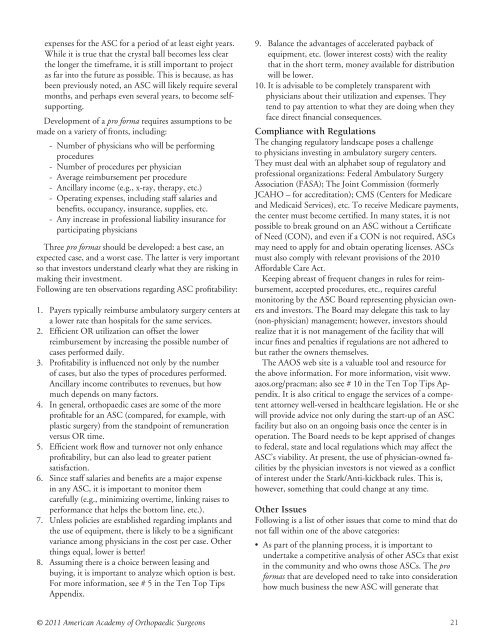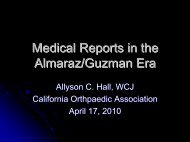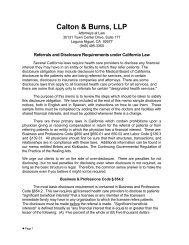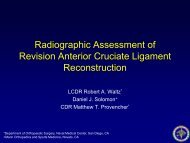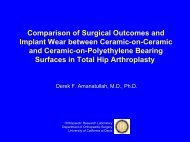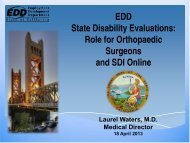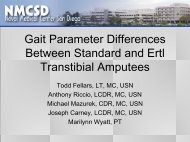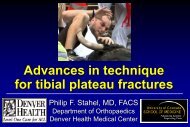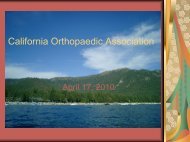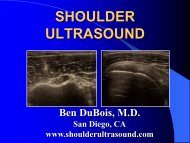Enhancing Your Practice's Revenue - California Orthopaedic ...
Enhancing Your Practice's Revenue - California Orthopaedic ...
Enhancing Your Practice's Revenue - California Orthopaedic ...
- No tags were found...
Create successful ePaper yourself
Turn your PDF publications into a flip-book with our unique Google optimized e-Paper software.
expenses for the ASC for a period of at least eight years.While it is true that the crystal ball becomes less clearthe longer the timeframe, it is still important to projectas far into the future as possible. This is because, as hasbeen previously noted, an ASC will likely require severalmonths, and perhaps even several years, to become selfsupporting.Development of a pro forma requires assumptions to bemade on a variety of fronts, including:- Number of physicians who will be performingprocedures- Number of procedures per physician- Average reimbursement per procedure- Ancillary income (e.g., x-ray, therapy, etc.)- Operating expenses, including staff salaries andbenefits, occupancy, insurance, supplies, etc.- Any increase in professional liability insurance forparticipating physiciansThree pro formas should be developed: a best case, anexpected case, and a worst case. The latter is very importantso that investors understand clearly what they are risking inmaking their investment.Following are ten observations regarding ASC profitability:1. Payers typically reimburse ambulatory surgery centers ata lower rate than hospitals for the same services.2. Efficient OR utilization can offset the lowerreimbursement by increasing the possible number ofcases performed daily.3. Profitability is influenced not only by the numberof cases, but also the types of procedures performed.Ancillary income contributes to revenues, but howmuch depends on many factors.4. In general, orthopaedic cases are some of the moreprofitable for an ASC (compared, for example, withplastic surgery) from the standpoint of remunerationversus OR time.5. Efficient work flow and turnover not only enhanceprofitability, but can also lead to greater patientsatisfaction.6. Since staff salaries and benefits are a major expensein any ASC, it is important to monitor themcarefully (e.g., minimizing overtime, linking raises toperformance that helps the bottom line, etc.).7. Unless policies are established regarding implants andthe use of equipment, there is likely to be a significantvariance among physicians in the cost per case. Otherthings equal, lower is better!8. Assuming there is a choice between leasing andbuying, it is important to analyze which option is best.For more information, see # 5 in the Ten Top TipsAppendix.9. Balance the advantages of accelerated payback ofequipment, etc. (lower interest costs) with the realitythat in the short term, money available for distributionwill be lower.10. It is advisable to be completely transparent withphysicians about their utilization and expenses. Theytend to pay attention to what they are doing when theyface direct financial consequences.Compliance with RegulationsThe changing regulatory landscape poses a challengeto physicians investing in ambulatory surgery centers.They must deal with an alphabet soup of regulatory andprofessional organizations: Federal Ambulatory SurgeryAssociation (FASA); The Joint Commission (formerlyJCAHO – for accreditation); CMS (Centers for Medicareand Medicaid Services), etc. To receive Medicare payments,the center must become certified. In many states, it is notpossible to break ground on an ASC without a Certificateof Need (CON), and even if a CON is not required, ASCsmay need to apply for and obtain operating licenses. ASCsmust also comply with relevant provisions of the 2010Affordable Care Act.Keeping abreast of frequent changes in rules for reimbursement,accepted procedures, etc., requires carefulmonitoring by the ASC Board representing physician ownersand investors. The Board may delegate this task to lay(non-physician) management; however, investors shouldrealize that it is not management of the facility that willincur fines and penalties if regulations are not adhered tobut rather the owners themselves.The AAOS web site is a valuable tool and resource forthe above information. For more information, visit www.aaos.org/pracman; also see # 10 in the Ten Top Tips Appendix.It is also critical to engage the services of a competentattorney well-versed in healthcare legislation. He or shewill provide advice not only during the start-up of an ASCfacility but also on an ongoing basis once the center is inoperation. The Board needs to be kept apprised of changesto federal, state and local regulations which may affect theASC’s viability. At present, the use of physician-owned facilitiesby the physician investors is not viewed as a conflictof interest under the Stark/Anti-kickback rules. This is,however, something that could change at any time.Other IssuesFollowing is a list of other issues that come to mind that donot fall within one of the above categories:• As part of the planning process, it is important toundertake a competitive analysis of other ASCs that existin the community and who owns those ASCs. The proformas that are developed need to take into considerationhow much business the new ASC will generate that© 2011 American Academy of <strong>Orthopaedic</strong> Surgeons21


